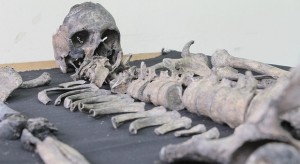Missing Migrants Seeking truth on the border
Several hundred undocumented migrants die each year of heatstroke or at the hands of organized crime as they attempt to cross the deserts of Mexico, Texas, and Arizona. Law enforcement officials struggle to identify the bodies, while families in Mexico and Central America wait anxiously, not knowing what happened to their relatives.
Mercedes Doretti, a cofounder of the Argentine Forensic Anthropology Team (EAAF, for its initials in Spanish), is trying to change this situation. As a forensic anthropologist, she can’t rewrite U.S. immigration policy, but she can identify immigrants’ remains and restore them to their families. Three years ago, she started a project, called “Missing Migrants,” to do just that.
Since starting their work over two decades ago, members of the EAAF have worked in 46 countries, using DNA samples and other techniques to identify the bodies of those killed during dictatorships and genocides. The team realized that their skills and experience were needed at the US/Mexico border while working on a project in Ciudad Juárez. They couldn’t identify all the bodies which officials had found. “We realized those remains probably belonged to migrants,” Doretti says. The ultimate goal of Missing Migrants is to establish a regional forensic database of missing persons and family members’ DNA that would help identify migrants who go missing during their journey north.

Members of EAAF exhuming a mass grave at San Vicente Cemetery in Córdoba, Córdoba Province, Argentina in February 2003. Photo: EAAF.
Doretti never planned to work outside Argentina—or even in the field of human rights. In 1987, she graduated from the University of Buenos Aires with a degree in academic anthropology. Shortly afterwards, a forensic anthropologist from the United States approached her about helping document the Argentine military’s human rights abuses. “We wanted justice and we wanted historical clarification and we wanted to support families of missing persons,” she explains. Since then, EAAF has used anthropologic techniques to identify the remains of about 2000 people who disappeared during Argentina’s military dictatorship (1976–1983). The military disposed of their victims’ by burying them in unmarked or mass graves or by throwing them out of planes into the Atlantic Ocean. Families were left wondering what had happened to their loved ones. People “are paralyzed by this situation,” Doretti says. “If there’s someone missing in your family, you can’t rest until you find that person.”
To identify the remains, Doretti and her colleagues studied a number of techniques until then unheard of in Latin America. Because of their expertise, they started to get phone calls from human rights organizations in other countries. These NGOs sought scientists with the skills and the independence to establish the truth about the past. “In Latin America, most of the medical-legal institutes depend on the state,” Doretti explains, “[so] they were often questioned by human rights organizations.”
Doretti is part of a growing movement of scientists who emply their skills and knowledge in service of human rights. From Chile to Spain, scientists have provided not only relief to grieving families but also key evidence for human rights trials. Technological advances have made these scientists’ work easier over time. In the late 1980s, it became possible to extract DNA from skeletal remains. “In most of the countries where we work, there are very poor or nonexistent medical or dental records,” Doretti says. “And oftentimes, the population that we work in is very poor and doesn’t go to the dentist or the doctor. Or they’re very young, and they don’t have anything in particular to identify them.” The ability to cross-check DNA from remains and from living relatives enabled the EAAF to carry out identifications of disappeared Argentines, and the technique is a key part of their work around the world.
Since starting the Missing Migrants project three years ago, Doretti’s team has opened DNA databanks in El Salvador, Honduras, and the Mexican state of Chiapas. Now, they’re trying to match DNA from migrants’ remains with the DNA of families.
The migrants, explains Doretti, are usually young. They “start this journey because of lack of opportunities in their own countries. Often, they are the only hope of their families to get out of extreme poverty. And they also have their [own] dreams: They want to do something in life. It’s really devastating to see these 18-year-old, 20-year-old kids that just died in the desert in Arizona or in Texas.” Except in Pima, Arizona, the team is unable to conduct massive DNA studies and instead works on the basis of probable identification. After conducting interviews with the families of missing migrants, the team guesses who the migrant might have been and checks the DNA of a limited number of families.
Border deaths are “extremely sad,” Doretti laments, “because [they] could be avoidable if there were an immigration policy that allowed immigration in a different way.” Fortunately, missing migrants haven’t always perished in the desert: They can have other reasons for not communicating with their families. In the past three years, a handful of missing migrants—five from Honduras and several from El Salvador—have contacted their families to tell them they’re alive.
Eilís O’Neill is a freelance journalist currently based in Buenos Aires, Argentina. She works in print and radio with a particular focus on social issues and gender.














